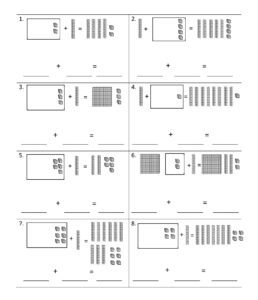COMMON CORE MATH ACTIVITIES
Meeting the Needs of ALL Students!
1st Grade, Activity 9: Represent and Solve Problems Involving Addition and Subtraction
Use addition and subtraction within 20 to solve word problems involving situations of adding to, taking from, putting together, taking apart, and comparing, with unknowns in all positions. (e.g., by using objects, drawings, and equations with a symbol for the unknown number to represent the problem)-Problem Solving of Addition and Subtraction.
Which Answer Makes Sense?
- Group: Whole Class/Three
- Materials: Which Answer Makes Sense cards, 2-color counters
Review students’ understanding of the words almost, about, a lot, and a few by providing situations in which the words are used. Assign the class to work in groups of three. Identify one student as Student A, identify another as Student B, and identify the third student as Student C. Give each group 100 two-color counters. Instruct Student A to count out 2 counters, Student B to count out 15 counters, and Student C to count 30 counters. Have group members move the other counters aside. Read the problem below aloud.
I have 20 pencils. I let students borrow almost all my pencils. About how many pencils are left? Tell students to let the counters represent the pencils. Ask them to look at the number of counters each person in the group has and decide which student has an amount that will describe a reasonable number of pencils left. (2) The student with 2 counters has an amount that is close to the number of pencils left.
Cut out the Which Answer Makes Sense cards so that they can be displayed one at a time on the overhead or document viewer. Before displaying the problem, tell each group member how many counters students should take for each problem. (See the numbers on the sheet for each problem.) After displaying the problem, call on volunteers to read the problem aloud. Group members decide among themselves which student has the most reasonable amount that will make sense. Call on students to read the answer aloud. Remind students to answer questions in complete sentences.




